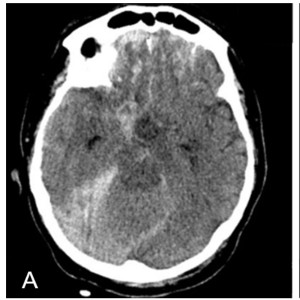Concomitant high-risk pulmonary embolism and subdural hematoma: endo-vascular system thrombolysis as a possible solution to a difficult challenge

Accepted: 22 September 2023
All claims expressed in this article are solely those of the authors and do not necessarily represent those of their affiliated organizations, or those of the publisher, the editors and the reviewers. Any product that may be evaluated in this article or claim that may be made by its manufacturer is not guaranteed or endorsed by the publisher.
Acute pulmonary embolism (PE) is a challenging and potentially fatal cardiovascular disorder. In high-risk patients, percutaneous catheter embolectomy may be considered when thrombolysis is contraindicated or has failed. We hereby discuss the case of a 60-year-old man who was found unconscious on the ground with signs of head trauma and respiratory failure. He was found to have a massive pulmonary embolism and multiple basilar skull fractures associated with slight subdural and subarachnoid hemorrhages. His acute treatment required a multidisciplinary discussion and approach. EkoSonic™ Endovascular System (EKOS) thrombolysis was successfully performed. The patient required intensive care unit (ICU) monitoring and treatment for 31 days. Upon discharge, henoxaparin 4000 UI twice per day was prescribed as anticoagulant, without any evidence of pulmonary hypertension or severe neurological sequelae.
Wendelboe AM, Raskob GE. Global Burden of Thrombosis: Epidemiologic Aspects. Circ Res 2016;118:1340–1347. DOI: https://doi.org/10.1161/CIRCRESAHA.115.306841
Barco S, Valerio L, Gallo A, et al. Global reporting of pulmonary embolism-related deaths in the World Health Organization mortality database: Vital registration data from 123 countries. Res Pract Thromb Haemost 2021;5:e12520. DOI: https://doi.org/10.1002/rth2.12520
Casazza F, Becattini C, Bongarzoni A, et al. Clinical features and short term outcomes of patients with acute pulmonary embolism. The Italian Pulmonary Embolism Registry (IPER). Thromb Res 2012;130:847-52. DOI: https://doi.org/10.1016/j.thromres.2012.08.292
Kearon C, Akl EA, Ornelas J, et al. Antithrombotic Therapy for VTE Disease: CHEST Guideline and Expert Panel Report. Chest 2016;149:315-352. DOI: https://doi.org/10.1016/j.chest.2015.11.026
Giri J, Sista AK, Weinberg I, et al. Interventional Therapies for Acute Pulmonary Embolism: Current Status and Principles for the Development of Novel Evidence: A Scientific Statement From the American Heart Association. Circulation 2019;140:e774-e801. DOI: https://doi.org/10.1161/CIR.0000000000000707
Meyer G, Vicaut E, Danays T, et al. Fibrinolysis for patients with intermediate-risk pulmonary embolism. N Engl J Med 2014;370:1402-11. DOI: https://doi.org/10.1056/NEJMoa1302097
Yılmaz F, Tekin Y, Toprak N, et al. A case of massive pulmonary embolism causing cardiac arrest managed with successful systemic thrombolytic in the emergency department. Emerg Care J 2022;18:10827. DOI: https://doi.org/10.4081/ecj.2022.10827
Arboscello E, Ponassi E, lomeo A, et al. Pulmonary embolism: the role of emergency scan and intervening radiology in medium-high-risk patients with pulmonary embolism. Emerg Care J 2010;6:5–10. DOI: https://doi.org/10.4081/ecj.2010.1.5
Meusel M, Pätz T, Gruber K, et al. PrEdictive value of coMbined pre-test proBability and blOod gas anaLysis In pulmonary emboliSM-the EMBOLISM study. Intern Emerg Med 2022;17:2245-2252. DOI: https://doi.org/10.1007/s11739-022-03075-w
McFarlane MJ, Imperiale TF. Use of the alveolar-arterial oxygen gradient in the diagnosis of pulmonary embolism. Am J Med 1994;96:57–62 DOI: https://doi.org/10.1016/0002-9343(94)90116-3
Thomson D, Kourounis G, Trenear R, et al. ECG in suspected pulmonary embolism. Postgrad Med J 2019;95:12-17. DOI: https://doi.org/10.1136/postgradmedj-2018-136178
Konstantinides SV, Meyer G, Becattini C, et al. 2019 ESC Guidelines for the diagnosis and management of acute pulmonary embolism developed in collaboration with the European Respiratory Society (ERS). Eur Heart J 2020;41:543-603. DOI: https://doi.org/10.1093/eurheartj/ehz405
Fiumara K, Kucher N, Fanikos J, Goldhaber SZ. Predictors of major hemorrhage following fibrinolysis for acute pulmonary embolism. Am J Cardiol 2006;97:127–129. DOI: https://doi.org/10.1016/j.amjcard.2005.07.117
Hepburn-Brown M, Darvall J, Hammerschlag G. Acute pulmonary embolism: a concise review of diagnosis and management. Intern Med J 2019;49:15–27 DOI: https://doi.org/10.1111/imj.14145
Vyas V, Goyal A. Acute Pulmonary Embolism. [Updated 2022 Aug 8]. In: StatPearls [Internet]. Treasure Island (FL): StatPearls Publishing; 2023 Jan-. Available from: https://www.ncbi.nlm.nih.gov/books/NBK560551/
Kilic A, Shah AS, Conte JV, Yuh DD. Nationwide outcomes of surgical embolectomy for acute pulmonary embolism. J Thorac Cardiovasc Surg 2013;145:373–377. DOI: https://doi.org/10.1016/j.jtcvs.2012.01.066
Dudzinski DM, Piazza G. Multidisciplinary Pulmonary Embolism Response Teams. Circulation 2016;133:98–103. DOI: https://doi.org/10.1161/CIRCULATIONAHA.115.015086
Giri JS, Piazza G. A midterm report card for pulmonary embolism response teams. Vasc Med 2018;23:72–74. DOI: https://doi.org/10.1177/1358863X17738337
Lin PH, Annambhotla S, Bechara CF, et al. Comparison of percutaneous ultrasound-accelerated thrombolysis versus catheter-directed thrombolysis in patients with acute massive pulmonary embolism. Vascular 2009;17:S137-47. DOI: https://doi.org/10.2310/6670.2009.00063
Planer D, Yanko S, Matok I, et al. Catheter-directed thrombolysis compared with systemic thrombolysis and anticoagulation in patients with intermediate- or high-risk pulmonary embolism: systematic review and network meta-analysis. CMAJ 2023;195:E833-E843. DOI: https://doi.org/10.1503/cmaj.220960
Copyright (c) 2023 the Author(s)

This work is licensed under a Creative Commons Attribution-NonCommercial 4.0 International License.
PAGEPress has chosen to apply the Creative Commons Attribution NonCommercial 4.0 International License (CC BY-NC 4.0) to all manuscripts to be published.


 https://doi.org/10.4081/ecj.2023.11558
https://doi.org/10.4081/ecj.2023.11558







